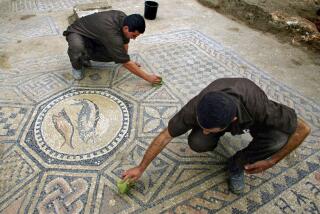Digging at Temple Mount Verges on the Unholy
- Share via
What may be priceless archaeological treasures from the Temple Mount in Jerusalem are being destroyed, and the government is standing by helplessly.
Without the required authorization from the Israel Antiquities Authority, the Waqf--the Islamic Religious Council in charge of the Old City’s Islamic sites, including the Temple Mount--has been illegally excavating and hauling off truckloads of earth and unceremoniously dumping the precious cargo into the Kidron Valley. The excavated dirt is carted off at night to avoid attention.
The excavation is being carried out underneath the Temple Mount in an underground vault, known as “Solomon’s Stables,” in which a mosque is also located.
In a protest published last week in the Hebrew daily Haaretz, archaeologist Ronny Reich, who is directing the most important excavation in Jerusalem, bemoaned what we might have learned from the Waqf excavation had it been carried out properly.
“What about all the pottery and coins we could have discovered,” he asked, “some still sealed in datable foundation trenches?” Several people claim that the dumped material is laced with architectural fragments as well as pottery shards.
Another prominent Jerusalem archaeologist, Gabriel Barkay, says his students saw remains from both the First and Second Temple periods in the excavated and dumped material.
Unfortunately, this is not the first time the Waqf has destroyed ancient archaeological features on the Temple Mount. In the 1980s, an unauthorized trench dug by the Waqf to relocate utilities uncovered an ancient wall thought by an archaeologist who briefly saw it to be from the time of King Herod and Jesus. It was probably a wall of one of the courts of the Second Temple, Herod’s Temple. The wall was six feet thick, and more than 16 feet of it was exposed, but the entire wall was quickly removed and the area covered before Israeli archaeological authorities could study it.
In 1993, in a case that was brought to prevent the Waqf from continuing to destroy archaeological features of the Temple Mount, the Israeli Supreme Court ruled that the Waqf was guilty of 35 violations of the antiquities law that involved irreversible destruction of important archaeological remains. Even while the lawsuit was pending, the Waqf continued to destroy ancient features on the Temple Mount.
The court nevertheless denied all relief because, it said, it had confidence that the Israeli government would prevent any future violations. The court noted the sensitive religious and political character of the case and the need to preserve public order.
It now seems that the court’s confidence in the government to prevent future destruction of archaeological remains on the Temple Mount was misplaced. The Waqf apparently has been conceded absolute control of the Temple Mount, and it will not even allow archaeologists to conduct a a survey of the area--something that many archaeologists have called for.
The government of Israel should stop the current illegal excavation by the Waqf and fence off the Kidron Valley dump so that it can be sifted and studied by competent archaeologists. Unfortunately, archaeologists cannot now learn as much as they would if they had excavated and studied the remains in context, but sifting to recover whatever is there will at least enable them to learn what can be salvaged.
More to Read
Sign up for Essential California
The most important California stories and recommendations in your inbox every morning.
You may occasionally receive promotional content from the Los Angeles Times.













